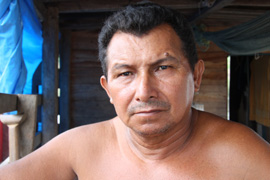Brazil’s river of death
Thousands of fish perish as drought dries up the Amazon’s Manaquiri River.

 |
|
Thousands of fish in the river have been killed by a sharp drop in water oxygen levels [ELIZONDO] |
The once free-flowing Manaquiri River, which runs through the state of Amazonas in northwest Brazil, is in the fight of its life against a spell of dry weather – and it appears to be losing the battle.
Thousands of dead fish are rotting on the river banks and hundreds more float on its surface, turning the area into a toxic cesspool.
Keep reading
list of 4 itemsAfter the Hurricane
World’s coral reefs face global bleaching crisis
Why is Germany maintaining economic ties with China?
Vultures circle overhead, picking away at the rotting carcasses. Even an alligator – one of the fiercest reptiles of the Amazon – floats belly up in the river.
Local fishermen say it has not rained in more than 25 days, leaving the large surrounding rivers in recession. This has in turn choked off the tributaries that provide fresh water to the Manaquiri.
With no fresh water coming in, oxygen levels in the river have dropped, leaving the fish to suffocate to death.
“One week the river water levels dropped, the next week all the fish died,” Bruno dos Santos, a fisherman, told Al Jazeera.
“In five days all the fish were dead. We have nothing left, only this ugly water.”
Fishermen unemployed
The town of Manaquiri lies about three hours from Manaus, the capital of Amazonas, and is home to a population of nearly 20,000, 800 of whom are fishermen. “All are unemployed now,” says dos Santos.
When Al Jazeera visited the town last week, water levels were so low that fishing boats were beached on the banks, immobile.
 |
| Fishermen, like Antonio Faria, are unable to find work due to the drought [Elizondo] |
“I used to make 100 or 200 reais ($57-$114) a day, but now nothing,” fisherman Gevaldo Maciel says.
“All I do all day now is eat, sleep and drink water. We are prisoners here, because the water is so low if we try to get to another river our boats will get stuck. So what are we supposed to do?”
Estimates suggest that the 14,000 of the town’s inhabitants who rely on the river as an economic lifeline are being adversely affected by the water shortage.
In November, local media reported that local schools suspended classes for 2,600 children who used the river as a means of transportation.
Some Amazon scientists warn that the drying up of the Manaquiri River may signal similar droughts occurring with higher frequency as the climate continues to change.
“This is something that fits with the climate changes that are happening now and that are expected to increase in the future,” says Philip Fearnside, a research professor in the Department of Ecology at the National Institute for Research in the Amazon (INPA) in Manaus.
“We have an El Nino [weather pattern] beginning this year and that means that water is warming up in the Pacific Ocean. Whenever that happens we have droughts here in the Amazon.”
Climate change ‘fact’
Fearnside, who has lived in the Amazon for the past 33 years and is considered one of Brazil’s top ecologists, says climate change theories are not built on speculation.
“This is something we have experience with and know from the data, it’s not something that depends on the outcome of a computer simulation,” he adds.
He says that while droughts can occur without climate change, such events are more likely to develop in a warming climate.
For the fishermen passing time on their now idle boats on the Manaquiri, the stench of fish carcasses baking under the sun is a constant reminder of their dwindling livelihood.
The ice chest on Antonio Farias’ boat, which used to be filled with fish, is now empty. Although he admits that he has no scientific expertise, he does offer his own theories for the cause of his community’s misery.
“I think this is related to some changes in the climate,” he says.
“Because for us, it’s been over 20 days without rain here. This was a surprise, because we have never experienced this before. It’s sad, all the dead fish.”
As Al Jazeera prepared to leave Manaquiri toward the end of the week, rain twice fell on the region , breaking the dry spell.
However, the fishermen say the damage has already been done. It will take a year at least, they say, for the river to recover.